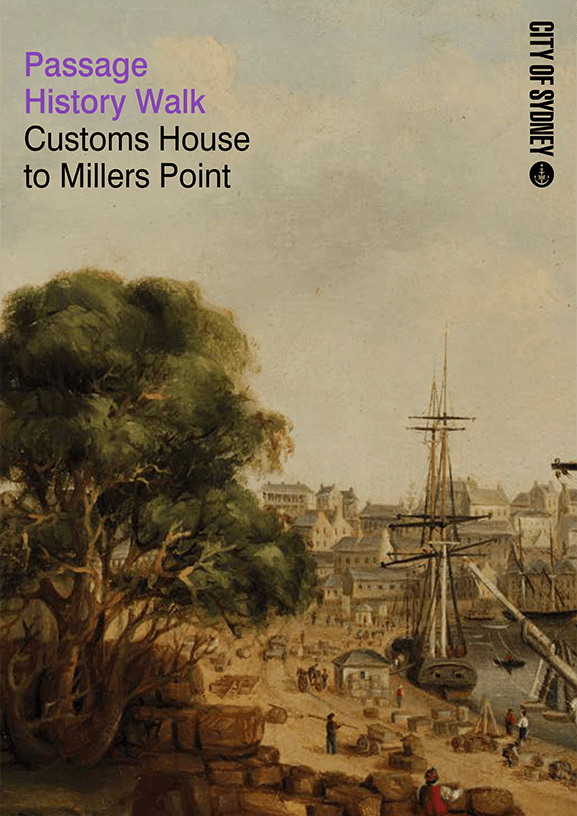History walks
Our self-guided walking tours introduce you to different aspects of Sydney’s history.

Each tour features a clear map with numbered points of interest and suggested museum stops along the way. All of the tours take 1 to 2 hours to complete.
There are 2 ways to access the City of Sydney’s series of history walks:
- Download the Culture Walks app to your mobile device.
- View or download the basic version of available history walks listed below.
City centre walks
Aboriginal people, sailors and whalers, convicts and soldiers have all walked this route. Remnants and traces of these early times can still be found among the bustling city streets. Places visited: Circular Quay, Millers Point, The Rocks.
This tour takes you to what was once the industrial backyard of Sydney and its busy market district. Haymarket became the focus of Sydney’s Chinatown as Chinese market gardeners and traders moved into the area from the 1870s. Places visited: Haymarket, Chinatown, former Spanish Quarter.
Much of Sydney’s commercial history can be seen in its buildings. This walk will take you from St James railway station through the heart of the financial and retail district. You’ll see the architectural features of key buildings and learn the history behind them. Places visited: Martin Place, George Street, Pitt Street.
A series of informal paths behind Sydney’s earliest main streets gave the settlers access to rear gardens, stables and storage areas. Over time, other laneways developed to provide rear access to the commercial buildings which came to dominate the area. Whether charming hidden gem or grungy service lane, they all contribute to the tapestry of the city. Places visited: Pitt Street, Circular Quay.
This tour pinpoints key sites where girls and women lived and worked, where they were educated and entertained, and where pioneering activist women held meetings, published journals and sometimes in the process expanded the possibilities for all women’s lives. Places visited: Hyde Park, Martin Place, Circular Quay.
From the drains and sewers under the surface of the ground to spectacular fountains in parks and plazas, the city is full of water features. Places visited: Circular Quay, Royal Botanic Garden, Martin Place, Hyde Park.
City east walks
In the 1960s, a scattering of nightclubs catering to lesbian, gay, bisexual, transgender, intersex and queer (LGBTIQ) crowds began to appear along Oxford Street. Over the following decades, more bars, clubs, restaurants, saunas and shops appeared giving the strip its celebratory name, ‘The Golden Mile’. It became synonymous with LGBTIQ life in Sydney.
Kings Cross and its adjoining locales have a rich and risque history. Departing from Kings Cross station, this circular route uncovers the history of Australia’s most famous red light district. Places visited: Kings Cross, Woolloomooloo.
Part guide, part history, this booklet presents the stories that inspired the bronze street plaques set in the pavement of Darlinghurst Road, Kings Cross. Each story highlights the colour, diversity and wit of the bohemians and artists, entrepreneurs, residents and business owners of Kings Cross. Places visited: Kings Cross.
City west walks
Although it began as a rural outpost scattered with ‘gentleman’s estates’, Newtown became increasingly populous with the coming of the railway in 1855. This tour, starting at Newtown station, leads you through one of Sydney’s most vibrant and gritty inner suburbs. Places visited: Newtown.
In past decades, the Pyrmont-Ultimo peninsula was Sydney’s industrial heartland, with its wharves, goods yards, woolstores and factories. Departing from Pyrmont Bridge, the tour visits key sites while exploring an often overlooked Sydney community. Places visited: Pyrmont, Ultimo.
Glebe has always been a place of contrasts. This tour explores the areas fascinating built environment and its long history of bohemian lifestyle, activism and intellectual pursuits. Places visited: Glebe.
Until 1850, Ultimo was semi-rural, with cornfields and cow paddocks. Members of the Gadigal people still harvested cockles on its foreshores. When the landscape was remade by sandstone quarrying and a new railway and goods yard, the suburb became crowded with factories, woolstores and workers’ housing. Eventually, its industrial sites were adapted for entertainment and education. Places visited: Ultimo, Darling Harbour.

Download free: Sydney Culture Walks app
History
Barani/Barrabugu (Yesterday/Tomorrow) walking tourSites in the City of Sydney that are associated with the histories of Aboriginal people.Published 20 October 2017History
Rock and Roll Walks of Fame ‘n’ ShameFrom the fashionable heights to the desperate depths of Sydney’s music heritage.Published 23 April 2018

